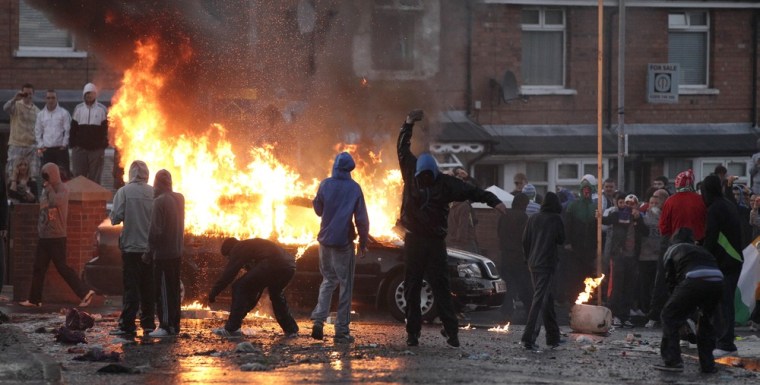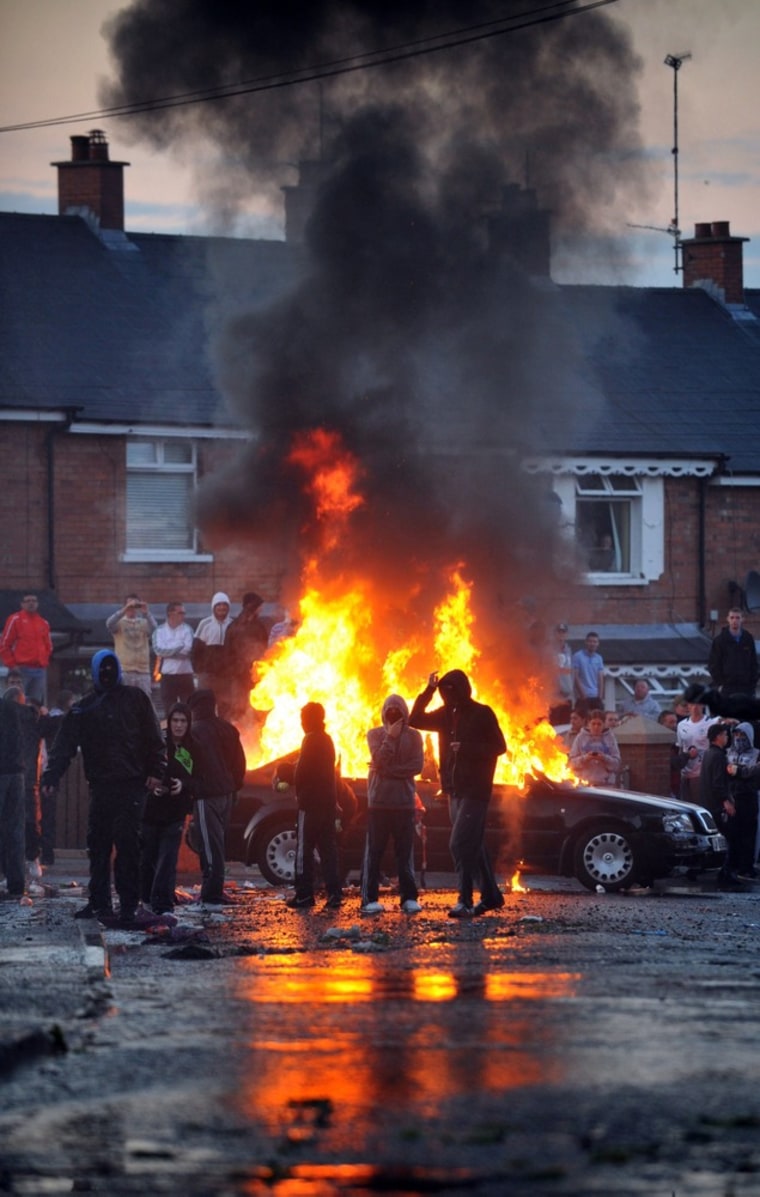Police firing plastic bullets and powerful water cannons forced Catholic militants away from a disputed Belfast road Tuesday as Northern Ireland's annual day of Protestant marches reached a fiery climax.
Catholic youths lashed out at police both before and after the marches by the Orange Order, a Protestant brotherhood whose yearly July 12 demonstrations celebrate 17th-century military triumphs over Catholics.
Many Catholics say the tradition is provocative and it often inspires a violent response from the province's minority.
Hundreds of mostly teenage Catholics, who covered their faces with masks and hoods, waged running street battles with police on the narrow streets of Ardoyne, a hard-line Irish nationalist enclave of red-brick rowhouses in north Belfast.
Police reported standoffs, smaller riots and the sporadic burning of hijacked cars in several other Catholic parts of this British territory. Several officers were injured, police said.
Communal wounds
The confrontations, which continued for several hours into the night, underscored how Northern Ireland's 1998 peace accord has failed to heal communal wounds that run decades deep.
Each year "The Twelfth," an official state holiday despised by most Catholics, lays bare the depths of Northern Ireland's divisions.
Three decades of fighting between mostly Protestant loyalists who want Northern Ireland to remain part of the United Kingdom and Irish nationalists, mainly Catholics, who want it to be part of a united Ireland tore the province apart during a three-decade period known as the "Troubles."
Ardoyne community worker Joe Marley said locals were retaliating for what he described as heavy-handed police tactics and the Orangemen's annual "muscle-flexing exercise."
The area's member of British Parliament, Protestant lawmaker Nigel Dodds, said most Catholic leaders in the area had toiled hard to keep the peace.
Dodds, an Orangeman who took part in the Ardoyne march, blamed a small band of Irish Republican Army dissidents for arming and directing the youths.
The IRA die-hards, he said, "were always intent on creating havoc on our streets and attacking the police as part of a wider agenda that has nothing to do with parades."
"It's a celebration, we don't want any trouble," said Eddie Whyte, 42, as he marched past Belfast City Hall on Tuesday morning. "If they are offended by the British flag, maybe they shouldn't be living in this country."
About 150 Ardoyne rioters, cheered by much larger crowds of Catholic spectators, tried to force their way on to the major local road in protest at a peaceful Protestant parade that police had just permitted to pass. British authorities had imposed strict conditions — including a requirement that the Protestants march to the beat of a lone snare drum.
Determined to prevent direct Protestant-Catholic street fighting, the police held their ground backed by three massive mobile water cannons that doused street fighters, journalists and spectators alike.
As darkness fell, the rioters reinforced their salvos of firecrackers, rocks, bricks and bottles with gasoline-filled Molotov cocktails.

Some burst harmlessly on the sides of police armored vehicles or more alarmingly amid rows of police, who wore helmets and flame-retardant boiler suits. Some rioters shouted "Burn! Burn!" as officers frantically batted out the flames.
Officers responded with dozens of single, targeted shots from plastic-bullet guns designed to knock down individual rioters without seriously wounding them. One rioter was about to throw a Molotov cocktail, only to drop it harmlessly at his feet when struck in the leg by one of the blunt-nosed cylinders.
It appeared certain that the casualty list would surge far higher than Tuesday's earlier total of 24 police officers and an unknown number of rioters. Typically, rioters injured in Belfast avoid checking into hospitals because they face police arrest there.
14-year-old rioter arrested
Tuesday's violence spread to several Catholic areas outside Belfast. In Northern Ireland's second-largest city of Londonderry, also known as Derry, police arrested a 14-year-old rioter and seized a crate of gasoline-filled bottles in the Catholic Bogside district.
In the predawn hours before Tuesday's parades, Catholic youths rioted at three front-line zones where fixed barricades — locally called "peace lines" — separate Irish Catholic and British Protestant turf.
Near Northern Ireland's main M1 motorway, rioters hijacked a bus and tried to drive it into police lines but instead crashed into a sidewalk.
Riots were also reported in Newry and Armagh as well as the Markets area in central Belfast.
Catholic and Protestant politicians have called for calm in recent days and urged people not to go into the streets to protest against the parades.
"We must not allow the progress that has been made to be thwarted by those who want to drag us back to the past," Northern Ireland's First Minister Peter Robinson said.
Last year, Catholic clashes with police surrounding the Protestants' July 12 parades ran for three nights and left 83 officers wounded, mostly on the bitterly contested streets of Ardoyne, long renowned as a power base of the outlawed Irish Republican Army.
"The Twelfth" officially commemorates the July 12, 1690, victory of Protestant King William of Orange versus his Catholic rival for the English throne, James II, at the Battle of the Boyne south of Belfast.
Underscoring their devotion to Protestantism and a British identity, the Orangemen march under banners depicting the British crown on an open Bible.

Orangemen once marched wherever they wanted in Northern Ireland, a state created on the back of Orange power as the predominantly Catholic rest of Ireland won independence from Britain in the early 1920s.
Catholic hostility to Protestant parades helped ignite warfare over Northern Ireland's future that claimed more than 3,600 lives from the late 1960s to mid-1990s, when cease-fires by the IRA and outlawed Protestant groups finally took hold.
As the IRA lowered its guns, activists from the IRA-linked Sinn Fein party began blocking Orangemen's traditional marching routes in several cities, towns and villages.
The tactic brought Northern Ireland to the brink of civil war — and ended in broad defeat for the Orangemen, who refused to negotiate on their marching rights until it was too late.
Britain punished the Orangemen's stubbornness by imposing bans on parades that met the heaviest opposition from Catholics.
Orangemen spent years mounting violent standoffs with British security forces in hopes of regaining lost ground, but eventually gave up.
The Crumlin Road beside Ardoyne is the only remaining parading point in Belfast that inspires recurring violence. There, the Orangemen have no obvious alternative way to march from their lodges to central Belfast and back.
In 2005, IRA dissidents opposed to their side's cease-fire first turned Ardoyne into the major July 12 sectarian flashpoint. They hurled homemade grenades at police from Ardoyne shop rooftops, wounding more than 100 officers.
On Tuesday, police seized control of those rooftops — only to see the Ardoyne extremists shift the battleground to a few streets away.